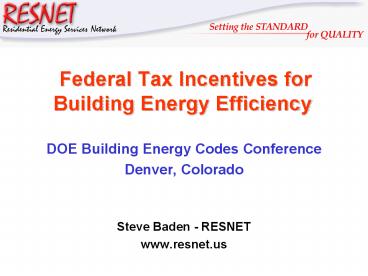Federal Tax Incentives for Building Energy Efficiency - PowerPoint PPT Presentation
1 / 33
Title:
Federal Tax Incentives for Building Energy Efficiency
Description:
Tight ducts located in conditioned space provide significant ... Interior, tight* Atlanta. SEER 13. SEER 13. SEER 13. SEER 13. SEER 14.5. SEER 14. SEER 14 ... – PowerPoint PPT presentation
Number of Views:70
Avg rating:3.0/5.0
Title: Federal Tax Incentives for Building Energy Efficiency
1
Federal Tax Incentives for Building Energy
Efficiency
- DOE Building Energy Codes Conference
- Denver, Colorado
- Steve Baden - RESNET
- www.resnet.us
2
RESNETs Key Services
- Maintain National Home Energy Rating Standards
- Accredit Rating Providers, Rating Software
Programs, Rater Training Providers - Work with the Mortgage Industry in Developing and
Promoting New Energy Mortgage Products
3
National Home Energy Rating Standards
- Rating Program Administration
- Technical Guidelines
- Rater Training and Certification
4
What Are Ratings Used For?
- Energy Efficient Mortgages
- ENERGY STAR Home labeling
- Performance option for energy code compliance in
16 states - Federal tax credit
5
2005 Energy Policy Act
- Signed Into Law by President Bush in August
2005 - First Comprehensive Energy Legislation since
1992 - Among Provisions is Tax Incentives for
Building Energy Efficiency
6
2005 Energy Policy Act
- Key Building Tax Incentives
- New Energy Efficient Homes Tax Credit
- Existing Homes Tax Credit
- Commercial Building Tax Deduction
7
Federal Tax Incentives for Building Energy
Efficiency
- RESNET Web Site
- www.resnet.us/taxcredits
8
Federal Tax Credit for New Homes
- Site Built Homes
- 2,000 to builder for each home whose performance
is calculated to exceed Heating and Cooling Use
of Section 404 of 2004 Supplement of the IECC by
50 (Does not count water heating/renewable
energy production covered by other incentives)
9
Federal Tax Credit for New Homes
- Effective Dates
- Homes built after August 2005 and purchased
between January 1, 2006 and January 1, 2008
10
Federal Tax Credit for New Homes
- IRS Rule IRS 2006-27
- 3rd Party Inspection Required Certified by
RESNET or Equivalent Rating Certification
Organization - Software Tool Must Comply with RESNET Software
Test Specifications
11
- www.resnet.us/standards/tax_credits/procedures
12
Difference Between Tax Credit and IECC
- Rules are different for Tax Credits than IECC.
Water heating removed
13
RESNET Federal Tax Credit Software Specifications
- Auto-Generation of the Reference Homes (2004
Supplement to IECC) - HERS BESTEST
- RESNET HVAC Tests
- Duct Distribution System Efficiencies Tests
14
Federal Tax Credit Software Tools Accredited by
RESNET
- Energy Gauge USA (Florida Solar Energy Center)
- Micropas (Enercomp, Inc.)
- REM/Rate (Architectural Energy Corporation)
- Builder Energy Solutions (ICF Resources)
15
RESNET Federal Tax Credit Inspection
Specifications
- Homes Shall be Independently Field Tested
(Sampling Allowed) - Field Verification Shall Follow RESNETs Home
Energy Rating Procedures - Person Who Certify Homes Qualification for
Tax Credit Shall be Trained and Certified in
Accordance with RESNETs National Home Energy
Rating Procedures
16
IRS Form that Contractor Files
17
Florida Solar Energy Center Study
- Simulations and calculations performed using
- EnergyGauge USA qualified through
software test - Only one of many possible solutions provided
for each - climate (best orientation)
- No mechanical ventilation all homes with
natural - infiltration at 0.35 ach
- All insulation is assumed installation Grade I
- Results indicate that many new homes, in all
parts of the - country, may ultimately qualify for federal
tax credits.
18
Conclusions
- Qualification not difficult in very mild
climates - Window selection is important, with changes
in - SHGC making a significant difference, even
in - northern climates
- Efficient lighting and appliances provide
significant benefit - in cooling dominated climates
- Relatively standard envelope features can
make the goal - with only moderate increases in HVAC
efficiencies if ducts - are good
- Tight ducts located in conditioned space
provide significant - benefit for both heating and cooling.
19
FAQs On New Homes Credit
- Raters Builders
- www.resnet.us/taxcredits
20
Federal Tax Credit for Commercial Buildings
- Offers businesses a deduction of 1.80 per square
foot for commercial buildings that achieve a 50
reduction in annual energy, compared to
ASHRAE/IESNA 90.1-2001 - IRS Rule 2006-52
21
Federal Tax Credit for Existing Homes
- 10 tax credit to homeowner of up to a maximum
credit of 500 to improve the energy efficiency
of existing homes. - Covers
- Insulation
- Windows
- Doors
- ENERGY STAR labeled roofs
22
Federal Tax Credit for Existing Homes
- In Addition Includes
- Advanced Main Air Circulating Fan (50)
- High Efficiency Furnaces and Water Heaters
(150) - High Efficiency Heat Pumps (300)
- Maximum credit is 500, however
23
Federal Tax Credit for Existing Homes
- Effective Dates
- Improvements need to be made between January 1,
2006 and January 1, 2008
24
Federal Tax Credit for Existing Homes
- IRS Rule IRS 2006-26
- Products Must Meet Criteria in 2000 IECC
25
Legislation to Extend Federal Building Energy
EfficiencyTax Incentives
- Grassley-Baucus Bill (S 2401)
- Extends New Homes Builder Credit to December
31, 2010 - Extends Commercial Building Deduction to
December 31, 2010
26
Legislation to Extend Federal Building Energy
EfficiencyTax Incentives
- Snowe Feinstein Bill (S 3628)
- Extends New Homes Builder Credit to December
31, 2010 - Modifies andExtends Commercial Building
Deduction to December 31, 2010 - Creates Performance Based Tax Credit for
Existing Homes of Up to 4,000
27
2007 RESNET Building Performance
ConferenceFebruary 19 21 San Diego, CA
- Comprehensive Review of Enhancements to ENERGY
STAR Rating Standards - Federal Tax Credits
- www.resnet.us/conference
28
Become Part of the RESNET Network
- Join RESNET
- www.resnet.us/membership/become
29
Home Characteristics
Very similar to examples provided by Micropas
30
Envelope Characteristics
Light in color
31
Window Characteristics
To follow Micropas example
32
Lighting Appliances
high-efficiency fixtures / qualifying fixture
locations
33
HVAC Equipment
tight tested to 3 cfm 25,out per 100 ft2
conditioned area































